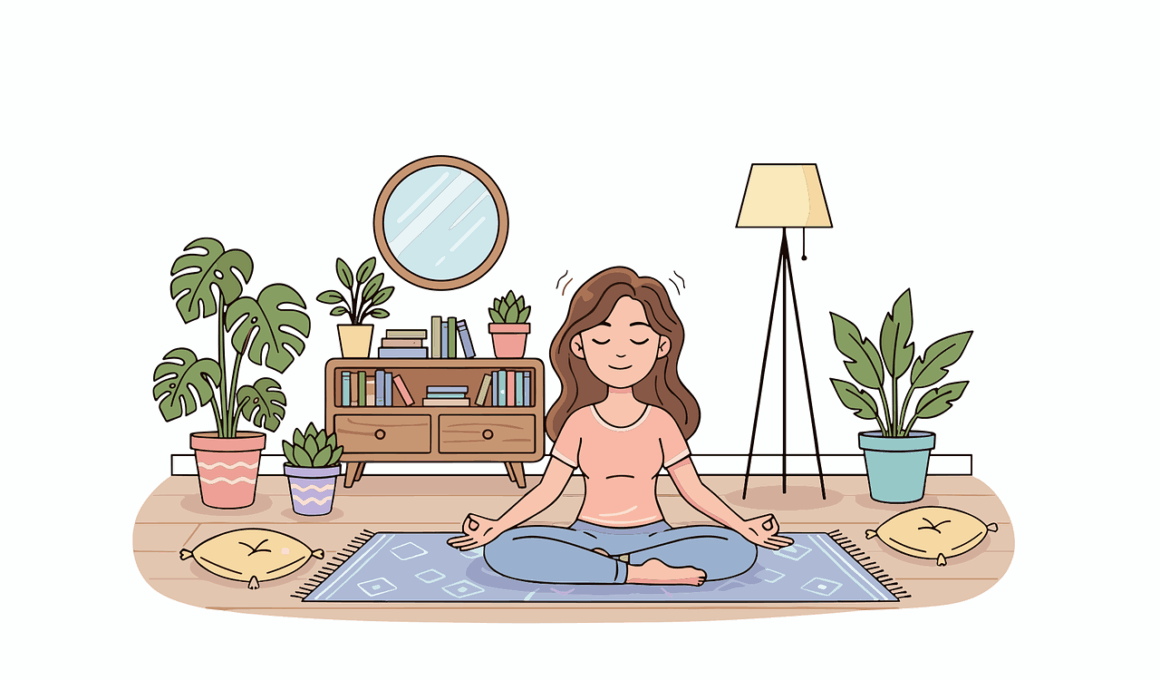Breathing Techniques to Complement Flexibility Exercises
Flexibility exercises are crucial for improving overall physical health. In addition to proper stretching, complementing these exercises with effective breathing techniques can yield better results. Proper breath control enhances oxygen flow, which is essential during flexibility workouts. By focusing on how you breathe, you can increase your movement range significantly. Among the various breathing techniques, diaphragmatic breathing is especially effective. This method encourages deeper, fuller breaths that engage the diaphragm, providing more energy during flexibility routines. When practicing stretching, synchronize your breath with each movement for maximum benefit. For instance, inhale while preparing for a stretch, and exhale as you deepen your stretch. Furthermore, understanding the importance of exhalation cannot be overstated. A controlled exhale aids in relaxation of muscles and helps release tension. Consider using a timer to practice specific breathing counts, such as inhaling for a count of four, holding for four, and exhaling for eight to promote calmness. Lastly, listen to your body. Pay attention to how breathing makes you feel during exercises. Every individual may require a slightly different approach to breathing, so find what feels best for you.
Yoga and Pilates are exemplary practices to incorporate various flexibility exercises. They often emphasize breath control, which plays an important role in enhancing flexibility. One well-known technique in both disciplines is the ujjayi breath. Also known as “victorious breath,” this technique involves slightly constricting the throat during the inhalation and exhalation phases. This creates a soothing sound, and it also improves concentration during exercises. Engaging in ujjayi breath during flexibility sessions can prolong your stretches while enhancing your mental focus. Another powerful technique is the 4-7-8 breathing method. Count to four as you inhale, hold your breath for seven counts, then exhale for eight counts. This method promotes relaxation and encourages deeper stretches. Incorporate this technique while performing gradual stretches like hamstring or quad stretches to gain maximum benefit. Pay attention to ongoing thoughts while practicing these breathing exercises. They can sometimes interfere with flexibility efforts. With practice, these breathing techniques can become second nature, positively impacting all types of workouts. Additionally, creating a calm environment free from distractions will further enhance the effectiveness of your breathing and stretching routine.
The Connection Between Breathing and Flexibility
Breathing intricately connects to flexibility exercises in various ways. As you practice flexibility training, you might notice how specific breathing techniques enhance your performance. Using slow, deep breaths allows the body to relax and lengthen muscles, making stretching more effective. On the contrary, shallow or rapid breaths can lead to tension, making it harder to deepen any stretch. Understanding this relationship can make you more attuned to your body’s needs. Experiment with different breathing sequences and observe how it impacts your flexibility. For instance, use relaxed inhalations and controlled exhalations while performing static stretches. This rhythmic breath pattern can create a relaxing environment, encouraging sustained stretches. Incorporating visualization while breathing can also aid flexibility. Picture your muscles gently expanding with each inhale and relaxing with every exhale, reinforcing the mind-body connection. Consistent application of these techniques over time leads to gradual improvements in flexibility. Familiarize yourself with your range of motion during stretches, paying attention to how different breathing styles impact your results. By integrating breathing techniques into your flexibility program, you’ll not only boost flexibility but elevate your overall workout experience too.
Another effective strategy is to combine breathing techniques with dynamic stretches. Dynamic stretches actively incorporate moving parts of the body, making them ideal when preparing for a workout. For instance, arm circles or leg swings are fantastic examples that can also benefit from synchronized breathing. Inhale as you prepare to swing your leg forward and exhale as you bring it back. This synchronization of breath and motion primes the muscle groups for increased flexibility and reduces the chances of injury. Practicing these dynamic stretches, in tandem with breathing techniques, creates a smooth transition into more static flexibility work. Additionally, these warm-up routines increase blood flow to the muscles, helping them respond more effectively to stretching. Maintain mindfulness throughout each dynamic stretch, observing how your breath guides your movements. Another technique to consider is box breathing, which combines inhaling, holding, and exhaling to promote focus and calmness. It’s particularly effective when preparing for more intense static stretches. Paying attention to your breathing can enhance your connection with each movement during workout routines, thereby maximizing the overall impact of your flexibility exercises.
Deepening the Stretch
Breathing techniques not only enhance flexibility exercises but also aid in deepening each stretch. Proper engagement of breath can relax surrounding muscles, allowing you to safely stretch further. One way to achieve this is by focusing on exhaling more deeply during stretches. When you exhale, visualize tension leaving your body. As you do this, deepen your stretch if it feels comfortable. The ideal approach is to hold the stretch while continuing this cycle of inhaling and exhaling to maintain ease. Explore techniques such as progressive muscle relaxation combined with your stretches, where you tense and relax specific muscle groups as you breathe deeply. This method can significantly enhance your flexibility. A useful tool during this process is a yoga strap. It aids in reaching depths you might not achieve otherwise. Incorporate the breathing technique of exhaling as you pull lightly on the strap to deepen each stretch safely. This level of assistance fosters a more profound feeling of elongation within those muscles. Thus, creating a harmonious atmosphere of breath and movement promotes flexibility while minimizing the risk of injury or strain.
Utilizing guided imagery can also significantly improve the benefits derived from breathing and flexibility exercises. As you perform each stretch, develop a narrative in your mind where each breath takes you deeper and deeper into relaxation and flexibility. This visualization can facilitate a more profound mind-body connection. Envision facilitating the oxygen flow to tight areas, supporting muscle relaxation. Additionally, consider implementing audio resources or short guided sessions that focus specifically on breathing techniques amidst flexibility workouts. Various apps and services offer this, enriching your sessions while simplifying coordination with breaths. Emphasizing the mental component strengthens the release of tension in the muscles and enhances overall effectiveness. Following a specific routine that incorporates these elements can make your workouts feel more harmonious. Over time, solidifying this routine engenders a sense of mindfulness within your flexibility session. Establishing a habit with consistent breathing is vital as it promotes collective improvements. Each progressive session becomes easier, elevating your overall wellness journey. Moreover, enhancing your flexibility translates into other physical activities, maximizing potential gain from your workouts.
Conclusion: Integrating Breathing Techniques
Integrating breathing techniques into flexibility exercises is essential for achieving optimal results. Begin by exploring various styles of breathing, identifying which suits your body the best. Emphasize consistent practice to experience significant advancements over time. Breathing provides a foundation for mindfulness, relaxation and effectiveness, contributing to successful stretching sessions. Whether it’s diaphragmatic breathing or engaging in techniques like box breathing, each method has unique benefits, enhancing flexibility. Always remember to remain conscious of your breath throughout your workouts. Observe how it feels to synchronize breathing with movement and stretching. The journey to improved flexibility ultimately forms a connection between mind and body. Through this journey, participation in additional physical activities becomes more enjoyable. As you deepen this practice, you may find transformational effects spill over into daily activities. Reaching new heights in flexibility contributes to better performance across various fitness domains, such as Pilates, yoga, and traditional workouts. Moreover, the accompanying mental clarity can enhance overall life quality. In conclusion, finding time to incorporate harmonious breathing during stretches can significantly improve your flexibility, unlocking new potential in your fitness journey.
Breathing Techniques to Complement Flexibility Exercises
Flexibility exercises are crucial for improving overall physical health. In addition to proper stretching, complementing these exercises with effective breathing techniques can yield better results. Proper breath control enhances oxygen flow, which is essential during flexibility workouts. By focusing on how you breathe, you can increase your movement range significantly. Among the various breathing techniques, diaphragmatic breathing is especially effective. This method encourages deeper, fuller breaths that engage the diaphragm, providing more energy during flexibility routines. When practicing stretching, synchronize your breath with each movement for maximum benefit. For instance, inhale while preparing for a stretch, and exhale as you deepen your stretch. Furthermore, understanding the importance of exhalation cannot be overstated. A controlled exhale aids in relaxation of muscles and helps release tension. Consider using a timer to practice specific breathing counts, such as inhaling for a count of four, holding for four, and exhaling for eight to promote calmness. Lastly, listen to your body. Pay attention to how breathing makes you feel during exercises. Every individual may require a slightly different approach to breathing, so find what feels best for you.


